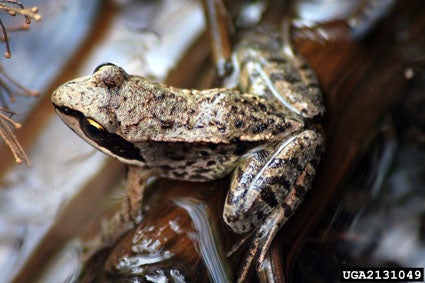SCIENTIFIC NAME:
Lithobates sylvatica
STATUS:
Rare and local in distribution. Documented from twelve locations in eastern Ridge and Valley and upper Piedmont from Mount Cheaha, in Talladega County, south to Horseshoe Bend in Tallapoosa County. Thought to be declining, but status not investigated in over two decades. HIGH CONSERVATION CONCERN.
DESCRIPTION:
Wood frogs are distinguished from other frogs by a dark mask through eyes that resembles that of a robber"s mask. Their body can have color variations from brown to pink and adults are 1.4 to 3.25 inches in length.
DISTRIBUTION:
The wood frog can withstand extreme cold and even freezing. They are found as far north as Labrador and Alaska and are the only frog that lives north of the Arctic Circle. The wood frog can be found from the Canadian Maritimes west to Alaska, with southern portions of its range extending from southern Minnesota and Wisconsin to Arkansas, Tennessee, Alabama and northern South Carolina to Maryland.
In Alabama, wood frogs are rare and local in distribution. They are documented from twelve locations in the eastern Ridge and Valley and upper Piedmont from Mount Cheaha, in Talledega County, south to Horseshoe Bend in Tallapoosa County. Wood frogs are thought to be declining in Alabama, but their status is poorly known.
HABITAT:
Wood frogs are usually found in moist, deciduous forests with a lot of leaf litter and lay eggs in vernal pools. During winter, they take shelter in leaf litter or under a log.
FEEDING HABITS:
Adult wood frogs feed on insects, arachnids, slugs, worms, and snails. Tadpoles are herbivorous.
LIFE HISTORY AND ECOLOGY:
Wood frogs have adapted to very cold climates by freezing over the winter. First, they stop breathing and their heart stops beating. They then produce this antifreeze like substance that prevents ice from freezing the water within their cells. However, ice does form in the spaces between the cells. Once the weather warms, the frogs begin to thaw and begin feeding and mating again.
Wood frogs emerge from hibernation in mid to late January to February usually during the first warm rainy nights of the year and congregate in large numbers at woodland pools. Breeding occurs from January to February. Males call explosively which sounds like the "quack" of a mallard duck. Eggs are laid in 3 to 4 inch diameter globular masses that are usually attached to existing vegetation found in the pond. Each mass may contain up to 3,000 eggs. The eggs hatch within 2 to 3 weeks and the tadpole stage lasts between 6 and 10 weeks. Maturity may be reached in 2 to 3 years depending on the sex and population of frogs. In the wild they usually live no more than 3 years.
REFERENCES:
https://www.nwf.org/Educational-Resources/Wildlife-Guide/Amphibians/Wood-Frog
AUTHOR: Ericha Nix, Wildlife Biologist, Alabama Division of Wildlife and Freshwater Fisheries






